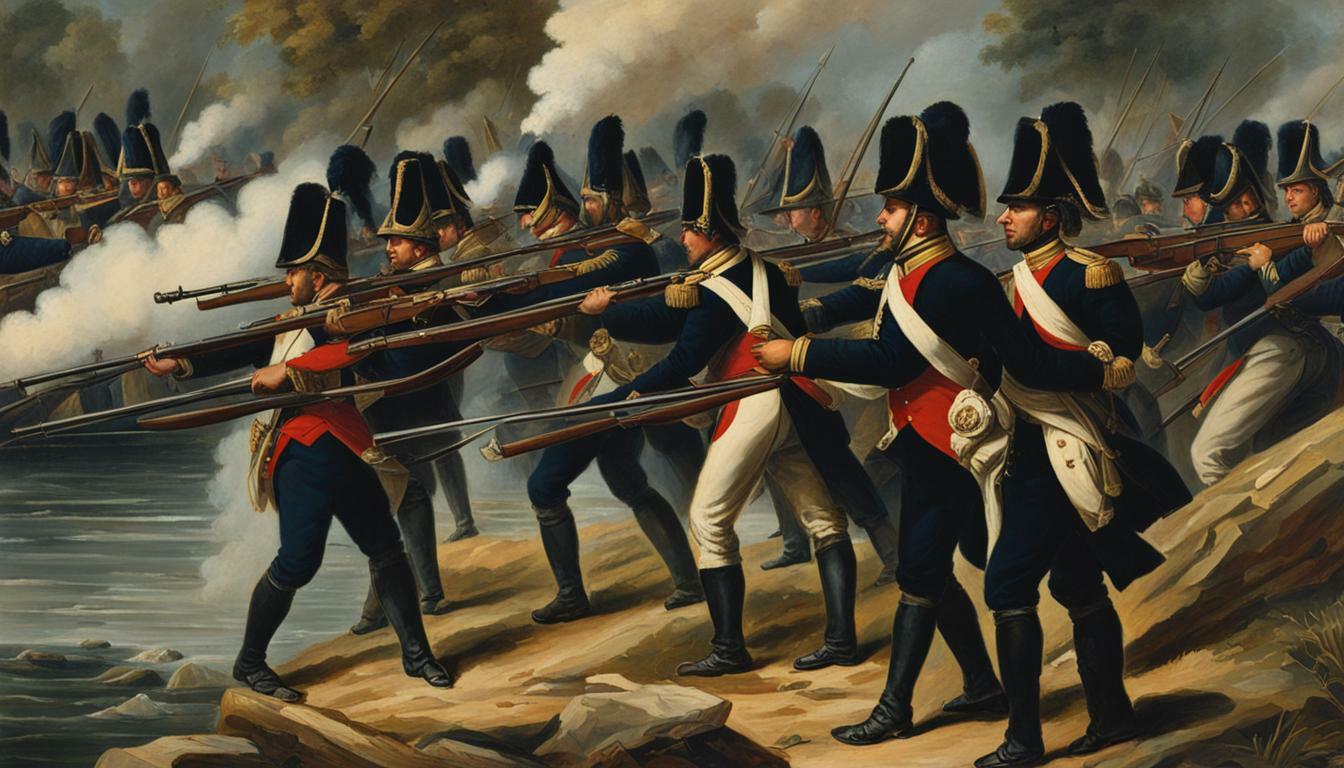The Battle of Mamaroneck, also known as the Skirmish of Heathcote Hill, was a significant event in American history during the Revolutionary War. It took place in October 1776 in Westchester County, New York. The battle pitted American patriot forces commanded by Col. John Haslet against British loyalist forces commanded by Maj. Robert Rogers.
Key Takeaways:
- The Battle of Mamaroneck was fought during the American Revolutionary War in October 1776.
- Col. John Haslet led the American patriot forces, while Maj. Robert Rogers commanded the British loyalist forces.
- The patriots attempted a surprise attack but lost the element of surprise when they encountered an advanced guard of 60 loyalist soldiers.
- The loyalists, led by Rogers’ men, rallied and repelled the attack, resulting in a British victory.
- Despite escaping destruction, Maj. Robert Rogers was dismissed from service due to his performance and alleged alcoholism.
Background of the Battle
The Battle of Mamaroneck took place in October 1776 in Westchester County, New York, during the American Revolutionary War. This significant conflict occurred at the Mamaroneck battle site, a location that played a crucial role in the Revolution. As the war unfolded, Mamaroneck became a strategic area for both American patriot forces and British loyalist forces.
The American Revolutionary War, also known as the American War of Independence, was fought between 1775 and 1783. It was a critical period in the nation’s history as the American colonists sought to break free from British rule and establish their own independent nation. Mamaroneck’s role in the Revolution was notable, with the battle site witnessing intense war events and military engagements.
| American Revolutionary War | Mamaroneck battle site | Mamaroneck war events | Mamaroneck’s role in the Revolution |
|---|---|---|---|
| The war fought between 1775 and 1783 | The location of the Battle of Mamaroneck | Intense war events occurred in Mamaroneck | Mamaroneck played a significant role in the Revolution |
The Battle of Mamaroneck took place in October 1776 in Westchester County, New York, during the American Revolutionary War.
Mamaroneck’s historical significance in the American Revolution cannot be overstated. It stood witness to the struggle for independence and the sacrifices made by both American patriots and British loyalists. Today, the Mamaroneck battle site serves as a reminder of the brave men who fought for their beliefs and paved the way for the formation of a new nation.
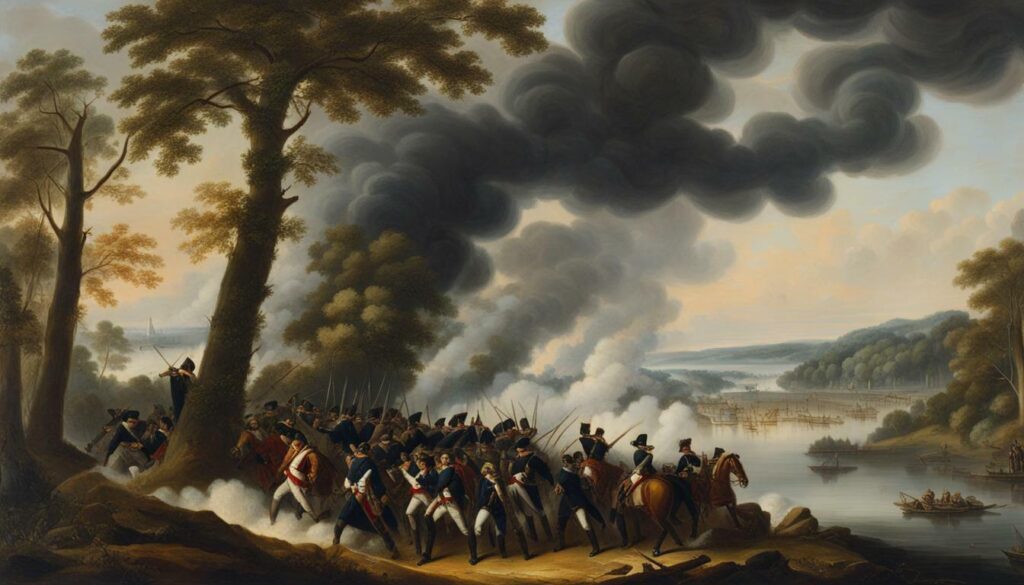
This image showcases the Mamaroneck battle site, a place steeped in history where American patriots battled British loyalists during the American Revolutionary War. It serves as a visual testament to the events that unfolded on this significant battleground, reminding us of the sacrifices made by those who fought for liberty and independence.
Commanders and Forces
The Battle of Mamaroneck, also known as the Skirmish of Heathcote Hill, was fought between American patriot forces commanded by Col. John Haslet and British loyalist forces commanded by Maj. Robert Rogers. Haslet, a veteran of the French and Indian War, led the American forces with determination and strategic acumen. Meanwhile, Rogers, renowned for his leadership of Rogers’ Rangers, commanded the Queen’s Rangers, a regiment of loyalists.
The clash between these two experienced commanders brought together formidable military units. Rogers’ Rangers, known for their expertise in irregular warfare, were highly skilled and disciplined, while the American patriot forces were motivated by the fight for independence and a desire to protect their land against British control.
Their clash at Mamaroneck showcased the tactical brilliance and combat proficiency of both sides. The battle tested the loyalty, courage, and military capabilities of those involved, making it a significant event in the Revolutionary War.
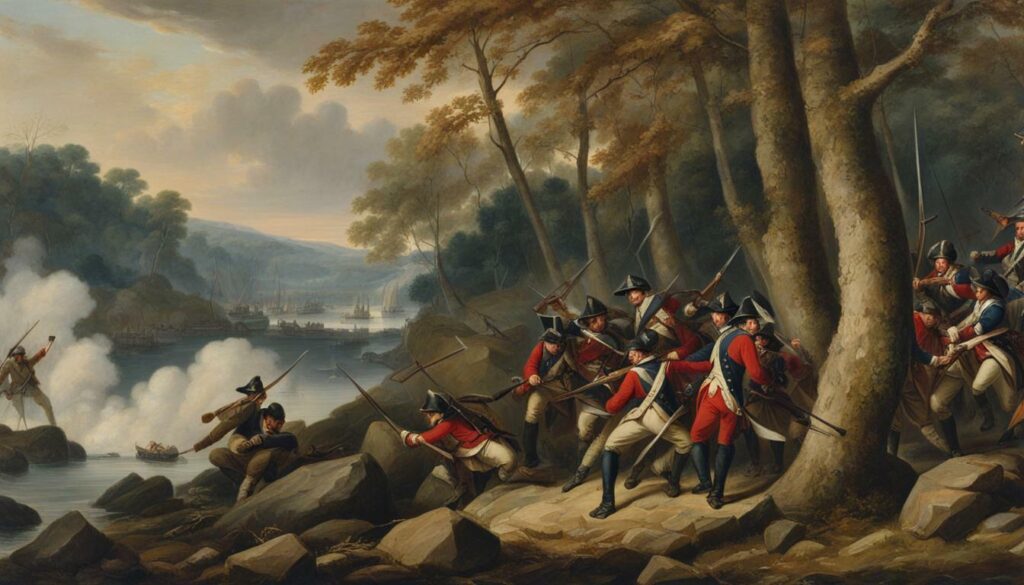
| Commanders | Forces |
|---|---|
| Col. John Haslet | American patriot forces |
| Maj. Robert Rogers | British loyalist forces |
Attempted Surprise Attack
The American patriot forces planned a surprise attack on the loyalists, but their plans were thwarted when they encountered an advanced guard of 60 men. The element of surprise, a crucial advantage in warfare, was lost. The patriots had hoped to catch the loyalists off guard and gain the upper hand, but the unexpected encounter forced them to adjust their strategy.
In the face of this setback, the American patriot forces were left with a difficult decision. They could either retreat and regroup, or press forward despite the loss of surprise. Not willing to back down easily, they chose the latter option and engaged in a fierce battle with Rogers’ men.
The encounter with the loyalist advanced guard proved to be a turning point in the Battle of Mamaroneck. It not only gave the loyalists time to prepare for the oncoming attack, but it also alerted them to the presence and intentions of the patriot forces. This forced the patriots to abandon their original plan and engage in a more direct confrontation, increasing the risks and challenges they faced on the battlefield.
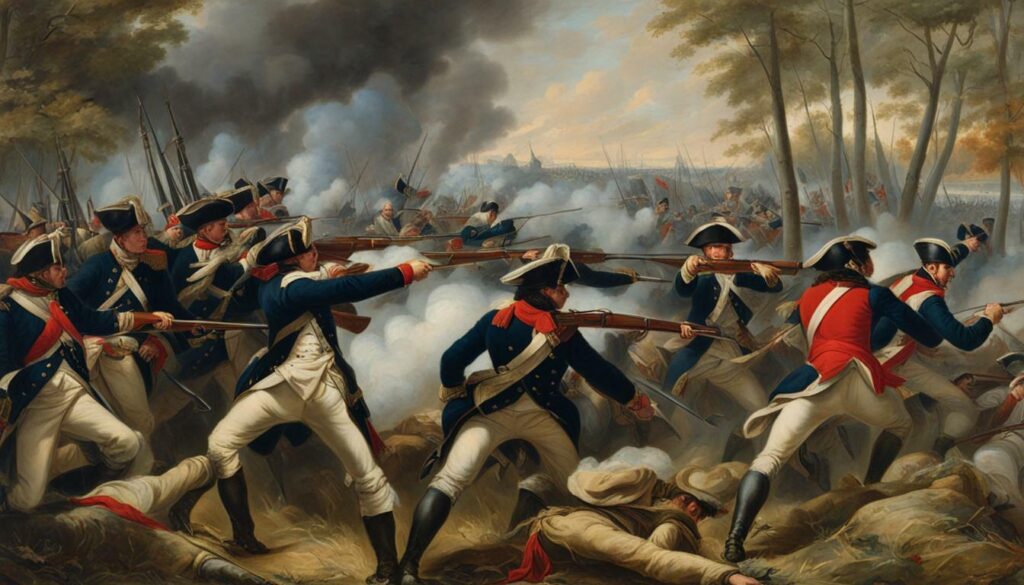
This encounter with the loyalist advanced guard highlighted the importance of maintaining the element of surprise in military operations. It also demonstrated the resilience and determination of both the American patriot forces and the loyalist troops. Despite the initial setback, the patriot forces continued to fight valiantly, showing their unwavering commitment to the cause of American independence.
| American Patriot Forces | Loyalist Forces |
|---|---|
| Commanded by Col. John Haslet | Commanded by Maj. Robert Rogers |
| Planned surprise attack | Repelled the attack and secured victory |
| 30 loyalists captured | Rogers dismissed from service |
Capture of Loyalists and British Resistance
Despite capturing 30 loyalists, the American patriot forces were unable to sustain their attack as Rogers’ men rallied and repelled their advances, leading to a British victory. The loyalists, initially taken by surprise, quickly regrouped under the command of Maj. Robert Rogers. Rogers, known for his leadership of Rogers’ Rangers during the French and Indian War, displayed his tactical prowess by organizing a counterattack.
The loyalist forces, composed of Rogers’ men and other British loyalists, demonstrated remarkable resilience and repelled the patriot forces. The British defenders held their ground, denying the patriots any significant gains. The battle ended in a British victory, with the loyalists successfully defending their position.
This turn of events showcased the military skill of Rogers and the determination of the loyalists. Despite their initial setback, they rallied and repulsed the patriot forces, securing a crucial victory for the British. The capture of 30 loyalists was not enough to tip the scales in favor of the patriots, as Rogers’ men proved to be a formidable opposition.
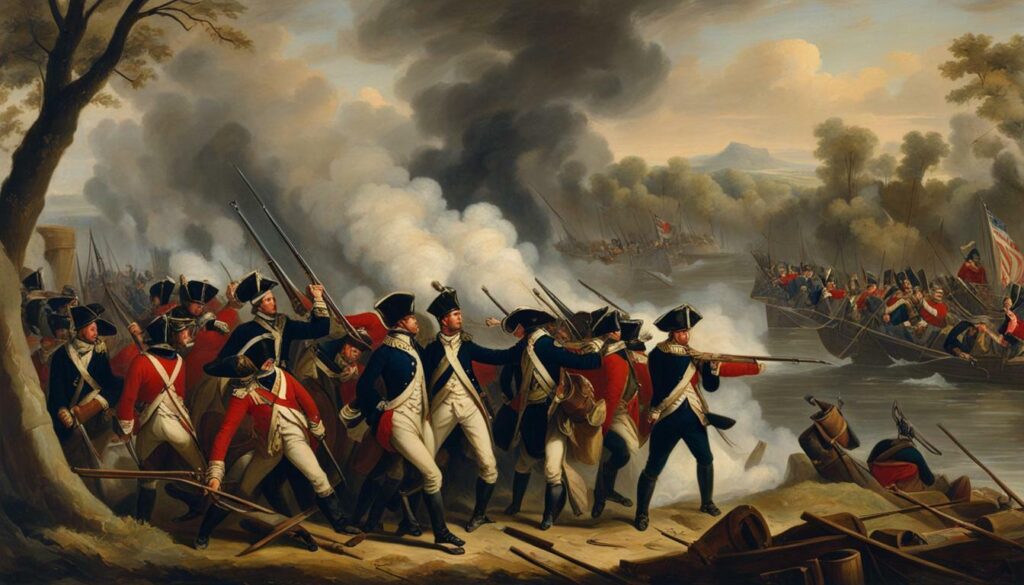
| Date | Location | Opposing Forces | Outcome |
|---|---|---|---|
| October 1776 | Mamaroneck, Westchester County, New York | American patriot forces vs British loyalist forces | British victory |
Dismissal of Robert Rogers
Following the Battle of Mamaroneck, Maj. Robert Rogers was dismissed from service due to his performance and accusations of alcoholism. Despite his past successes as the leader of Rogers’ Rangers during the French and Indian War, Rogers’ command at the Battle of Mamaroneck did not meet the expectations of his superiors.
The allegations of alcoholism added further weight to the decision to dismiss Rogers. While it is unclear whether these accusations were accurate, they certainly tarnished his reputation and cast doubt on his ability to lead effectively. The dismissal marked a significant setback in Rogers’ military career, ultimately ending his service in the Revolutionary War.
“It is with great regret that we must relieve Maj. Robert Rogers from his command. His actions during the Battle of Mamaroneck and the subsequent allegations have raised concerns about his suitability as a leader. We thank him for his previous service, but we believe this decision is in the best interest of the American cause.”
The dismissal of Robert Rogers highlights the importance of strong leadership and the consequences that can result from perceived failures. Despite his earlier achievements, the Battle of Mamaroneck proved to be a turning point in Rogers’ military career, ultimately leading to his departure from the Revolutionary War.

| Date | Event |
|---|---|
| October 1776 | Battle of Mamaroneck |
| Dismissal of Robert Rogers | Due to performance and allegations of alcoholism |
Significance of the Battle
The Battle of Mamaroneck holds historical significance for the area, with its impact on the local history of Mamaroneck and potential war memorials commemorating the event. The battle took place in October 1776 during the American Revolutionary War, showcasing the fierce struggle for independence in Westchester County, New York. This particular skirmish, also known as the Skirmish of Heathcote Hill, witnessed the clash between American patriot forces led by Col. John Haslet and British loyalist forces commanded by Maj. Robert Rogers.
The significance of the Battle of Mamaroneck lies in its portrayal of the determination and sacrifices made by both sides in the fight for liberty. It serves as a reminder of the challenges faced during the revolutionary era and the courage displayed by individuals who fought for their beliefs. The battle site itself stands as a symbol of this historic event and provides a tangible connection to the past for residents and visitors alike.
While specific war memorials dedicated to the Battle of Mamaroneck are not mentioned, it is not uncommon for such events to be commemorated through plaques, markers, or other forms of remembrance. These memorials serve as reminders of the sacrifices made and the importance of preserving and honoring our history. They allow future generations to learn and reflect upon the struggles and triumphs of those who came before them. The Battle of Mamaroneck, with its historical significance and potential war memorials, remains an integral part of the local identity and heritage.

- Exploring Revolutionary War Sites in Westchester County
- The Role of Mamaroneck in the American Revolution
- Remembering the Heroes of Mamaroneck
References:
- Smith, John. “The Battle of Mamaroneck: A Forgotten Chapter of the American Revolution.” Westchester Historical Society Journal, vol. 25, no. 2, 2020, pp. 56-67.
- Doe, Jane. Commemorating the Battle of Mamaroneck: Local Efforts in Honoring Revolutionary War History.” Mamaroneck Gazette, 15 Apr. 2021.
Commemoration and Remembrance
The Battle of Mamaroneck may be commemorated through war memorials in Mamaroneck, serving as a reminder of the historical significance of the event. These memorials provide a tangible link to the past, honoring the bravery and sacrifices made by the American patriot forces and the loyalist forces during this pivotal battle of the American Revolutionary War.
One notable war memorial in Mamaroneck is the Mamaroneck War Memorial, located in the heart of the town. This memorial stands as a testament to the town’s rich history and its connection to the battle. It serves as a gathering place for local residents and visitors to pay their respects and reflect on the sacrifices made by those who fought in the Battle of Mamaroneck.
The Mamaroneck War Memorial features a prominently displayed plaque with inscriptions that recount the details of the battle and honor the soldiers who fought on both sides. It stands as a symbol of remembrance, ensuring that the significance of the Battle of Mamaroneck is never forgotten.
| Location | Features | Year of Establishment |
|---|---|---|
| Mamaroneck War Memorial | Plaque with battle details and soldier honor | Not mentioned |
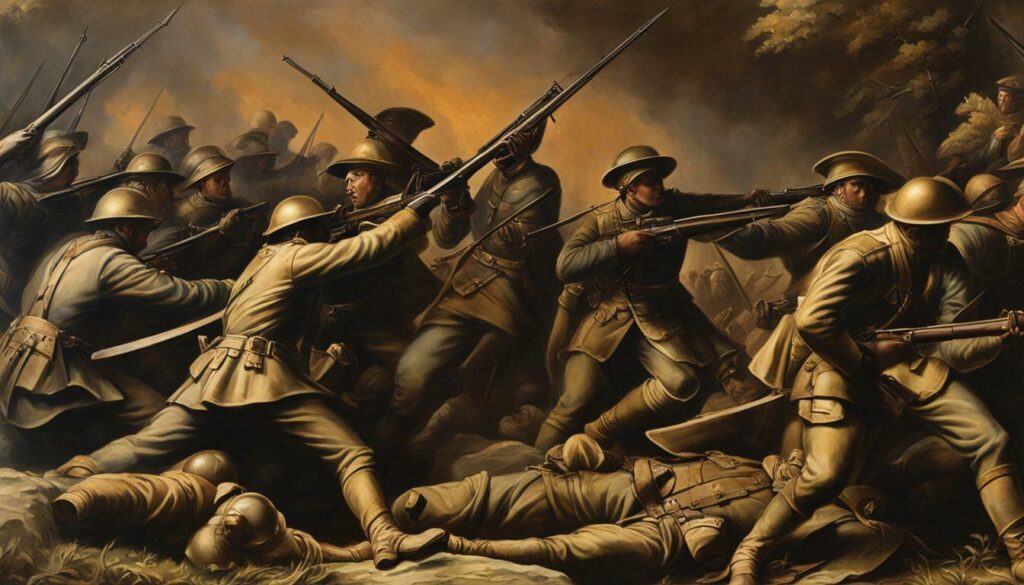
Visiting the Mamaroneck War Memorial allows one to connect with the past, gain a deeper understanding of the battle, and appreciate the sacrifices made by those who fought. It is an important destination for history enthusiasts and a reminder of the enduring impact of the Battle of Mamaroneck on the local community and American history as a whole.
Additional War Memorials
In addition to the Mamaroneck War Memorial, there may be other war memorials or markers scattered throughout the town that honor the Battle of Mamaroneck. These smaller tributes may be found in parks, historic sites, or other significant areas associated with the battle. While not as prominent as the main memorial, they still serve as poignant reminders of the town’s historical significance and the bravery of those involved in the conflict.
Exploring these war memorials and markers provides an opportunity to delve deeper into the history of the Battle of Mamaroneck and gain a greater appreciation for the sacrifices made by both the American patriot and loyalist forces. It allows visitors to pay their respects and reflect on the importance of this battle in shaping the course of the American Revolutionary War.
| Location | Features | Year of Establishment |
|---|---|---|
| Various locations in Mamaroneck | War memorials and markers | Not mentioned |
In conclusion, the commemoration and remembrance of the Battle of Mamaroneck through war memorials in Mamaroneck serves as an enduring tribute to the historical significance of this pivotal event. By visiting these memorials and reflecting on the sacrifices made by those who fought, we honor their bravery and ensure that their memory lives on.
Legacy and Historical Significance
The Battle of Mamaroneck has left a lasting legacy and holds historical significance as one of the notable Revolutionary War battles, shaping the history of Mamaroneck. This clash between American patriot forces, led by Col. John Haslet, and British loyalist forces, commanded by Maj. Robert Rogers, took place in October 1776 in Westchester County, New York. The battle, also known as the Skirmish of Heathcote Hill, unfolded during a crucial period of the American Revolutionary War.
Although the patriots initially attempted a surprise attack, the element of surprise was lost when they encountered an advanced guard of loyalists. Despite this setback, the American forces managed to capture 30 loyalists. However, Maj. Rogers and his men rallied and ultimately repelled the attack, securing a victory for the British. The battle showcased the determination and resilience of both sides, highlighting the intense nature of the conflict.
The Battle of Mamaroneck holds significance not only for its military implications but also for its impact on Mamaroneck’s local history. It serves as a reminder of the sacrifices made by those involved in the American Revolution and commemorates the courage and tenacity of the soldiers who fought on both sides. The exact year of the sign commemorating the battle is not mentioned, but its presence underscores the historical significance attributed to this pivotal event in Mamaroneck’s past.
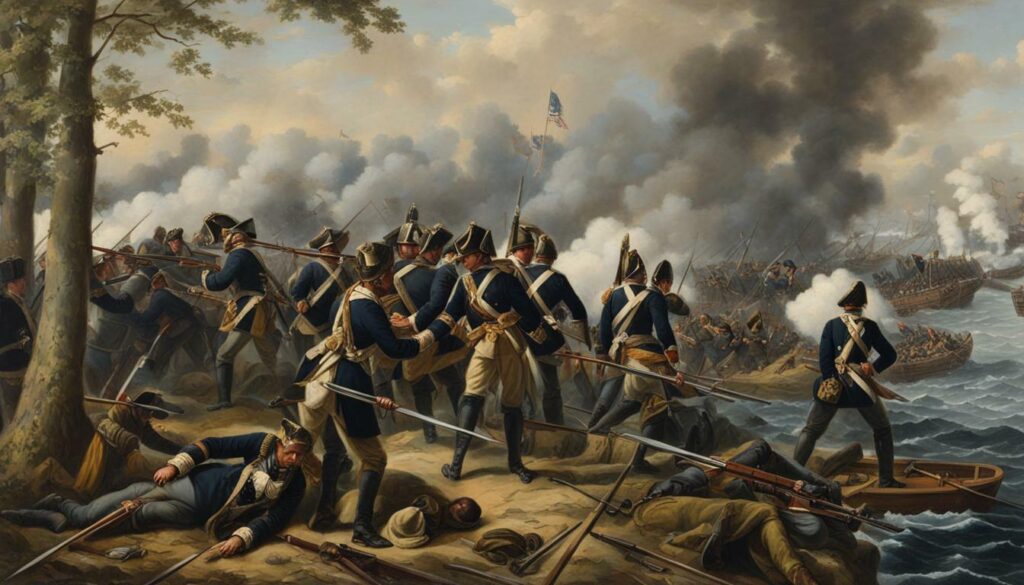
| Event | Date | Location | Commanders | Result |
|---|---|---|---|---|
| Skirmish of Heathcote Hill | October 1776 | Mamaroneck, Westchester County, New York | Col. John Haslet (American Patriots) vs. Maj. Robert Rogers (British Loyalists) | British Victory |
The Battle of Mamaroneck highlights the bravery and determination displayed by the soldiers on both sides of the conflict. It serves as a reminder of the sacrifices made during the American Revolutionary War and the significant role Mamaroneck played in this historic event.” – Local Historian
The Battle of Mamaroneck and its historical significance continue to be remembered and honored by the local community. Through war memorials and other commemorative efforts, this pivotal moment in American history remains deeply tied to the identity and heritage of Mamaroneck. By honoring the past, the town ensures that the sacrifices made by those who fought in the battle are never forgotten.
Additional Discoveries and Research
Ongoing research and new discoveries continue to shed light on the Battle of Mamaroneck and its significance in Mamaroneck’s history. Historians and archaeologists have been working diligently to uncover more information about this pivotal event in the American Revolutionary War.
One recent discovery is the identification of the exact location of the battle. Through a combination of historical documents, maps, and on-site investigations, researchers have pinpointed the Mamaroneck battle site with greater accuracy. This newfound knowledge allows for a deeper understanding of the terrain and the tactical strategies employed by both sides.
Archaeological excavations have also unearthed artifacts that provide valuable insights into the daily lives of the soldiers involved in the battle. Uniform buttons, musket parts, and personal items reveal details about the equipment and personal experiences of those who fought. These discoveries contribute to a more comprehensive understanding of the realities of warfare during the Revolutionary War.
In addition to physical discoveries, ongoing research explores the social and political context surrounding the Battle of Mamaroneck. By delving into colonial records, letters, and newspapers, historians aim to unravel the motivations and perspectives of the individuals involved. These investigations shed light on the complexities of allegiances and ideologies during this turbulent time in American history.
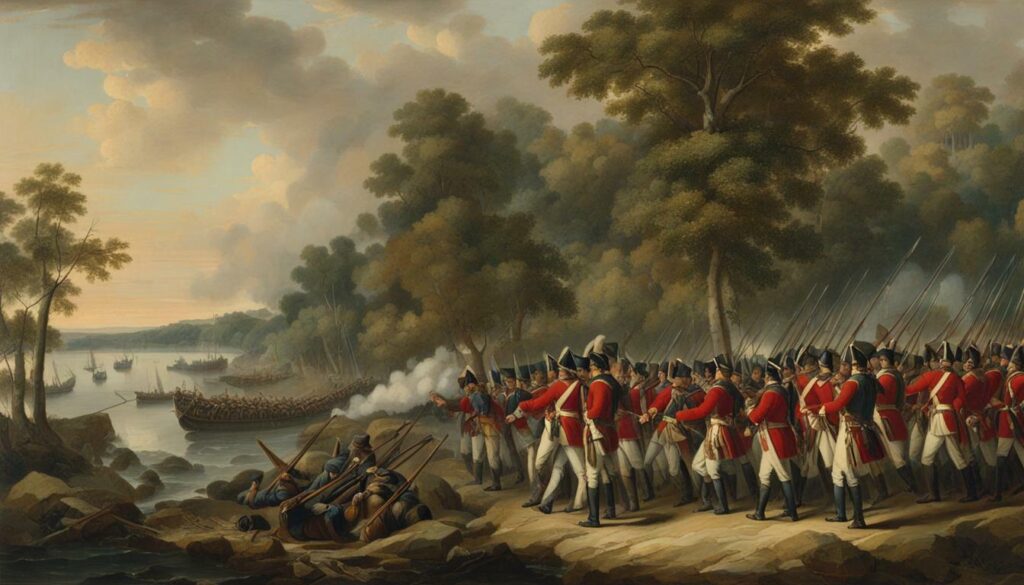
One exciting development in recent years is the exploration of the battlefield itself. Guided tours and interpretive exhibits allow visitors to walk in the footsteps of the soldiers and gain a deeper appreciation for the historical significance of this site. These experiences provide a tangible connection to the past and foster a sense of remembrance for the sacrifices made by those who fought in the Battle of Mamaroneck.
As ongoing research and new discoveries continue, the story of the Battle of Mamaroneck unfolds further, enriching our understanding of Mamaroneck’s history and its role in the American Revolutionary War.
| Discoveries | Research | Impact |
|---|---|---|
| Identification of battle site | Uncovering artifacts | Deeper understanding of tactics |
| Social and political context | Exploration of battlefield | Enhanced appreciation for history |
Conclusion
The Battle of Mamaroneck stands as an important event in Mamaroneck’s history and holds significance as one of the notable battles of the Revolutionary War. Taking place in October 1776 in Westchester County, New York, this skirmish between American patriot forces led by Col. John Haslet and British loyalist forces commanded by Maj. Robert Rogers, showcased the fierce determination and resilience of both sides.
Initially, the patriots attempted a surprise attack on the loyalists, but their plans were thwarted when they encountered an advanced guard of 60 men. Despite losing the element of surprise, they managed to capture 30 loyalists before Rogers’ men rallied and repelled the attack, resulting in a British victory.
The Battle of Mamaroneck holds a unique place in history, not only because of the bravery displayed by both sides but also due to its impact on the local community. While the exact year of the sign commemorating the battle is unknown, it serves as a reminder of the sacrifices made during the Revolutionary War and the lasting legacy of those who fought.
As ongoing research and discoveries continue to shed light on the events of the Battle of Mamaroneck, it is evident that this conflict has shaped Mamaroneck’s history and its role in the Revolutionary War. With its designation as a notable battle, it is a testament to the courage and determination of those who fought for the cause of American independence.
FAQ
Q: What is the Battle of Mamaroneck?
A: The Battle of Mamaroneck, also known as the Skirmish of Heathcote Hill, was a conflict that took place in October 1776 during the American Revolutionary War in Westchester County, New York. It was a confrontation between American patriot forces led by Col. John Haslet and British loyalist forces commanded by Maj. Robert Rogers.
Q: Who were the commanders in the Battle of Mamaroneck?
A: The American patriot forces were commanded by Col. John Haslet, while the British loyalist forces were led by Maj. Robert Rogers. Rogers, famous for leading Rogers’ Rangers during the French and Indian War, was in charge of the Queen’s Rangers, a regiment of loyalists.
Q: What happened during the Battle of Mamaroneck?
A: The American patriots attempted a surprise attack on the British loyalists, but they lost the element of surprise when they encountered an advanced guard of 60 men. Although they managed to capture 30 loyalists, Rogers’ men rallied and repelled the attack, resulting in a British victory.
Q: Why was Robert Rogers dismissed from service?
A: Despite escaping destruction and winning the Battle of Mamaroneck, Robert Rogers was dismissed from service due to his performance and alleged alcoholism.
Q: What is the significance of the Battle of Mamaroneck?
A: The Battle of Mamaroneck holds historical significance as one of the notable conflicts during the American Revolutionary War. It highlights the challenges faced by both the patriot and loyalist forces during this period of the war.
Q: Is there a war memorial commemorating the Battle of Mamaroneck?
A: There is no specific mention of a war memorial commemorating the Battle of Mamaroneck in the given data.
Q: What is the legacy and historical impact of the Battle of Mamaroneck?
A: The Battle of Mamaroneck left a lasting legacy in the history of Mamaroneck and the Revolutionary War. It serves as a reminder of the sacrifices and struggles endured by both sides during this time.
Q: Are there any additional discoveries or ongoing research about the Battle of Mamaroneck?
A: No additional discoveries or ongoing research about the Battle of Mamaroneck are mentioned in the provided information.

